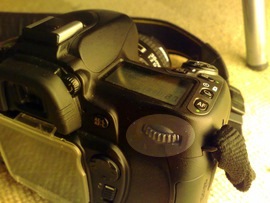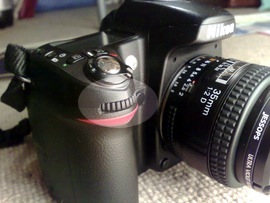Richie's Super Simple Guide to Taking Super Great Photos with an SLR Camera
So, you've got yourself a swishy new SLR camera, and already you've noticed the massive difference it's made in your photos. Hooray! But you still have this nagging feeling that you don't really know what you're doing and that maybe if you knew your way around this thing just a little bit better, then possibly your photos would be even MORE awesome?
Then you've come to the right place, partner, because I'm the pharmacist round here and today I'm dispensing photographic WISDOM. Yeeehaw!
Camera Knowledge
So, what are the things we need to know about in order to make sweet photographical love to our camera? Other than deciding which parts of the landscape/members of the family/body parts of the naked lady/gentleman you want to include in your shot, there are essentially three main things you need to think about when you are taking a photo:
Exposure
Exposure is how much light the camera lets in. Less exposure makes a photo dark, more exposure makes it light.
And that's pretty much all you need to know about exposure. This photography lark is easy.
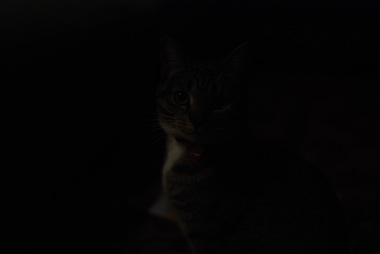
Nikon D80; Nikkor 35mm f/2.0 D; 1/25s, f/2.0, ISO:800
This delightful kitten is underexposed.
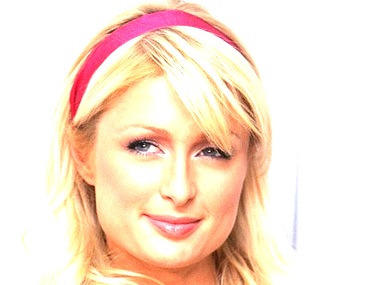
This person is overexposed. Ha ha ha do you see what I have done there?
Motion Blur

Nikon D80, Nikkor 35mm f/2.0 D; 1/10s, f/2.0, ISO:1000
She likes to move!
If the subject of your photo is zipping about, then they might end up blurry in the photo. And if the subject is still, but you're shaking the camera like a terrier worrying a rat, then your whole damn photo is gonna come out blurry. This is called MOTION BLUR and it is not the same thing as:
Focus
You know this one already: if something's out of focus, it'll be all soft and smudgy; if it's in focus, it will be crisp like a freshly ironed shirt.
But the thing we need to remember about focus, is that you don't actually focus on a thing. No sir. What you focus on is a distance. Anything that is a certain distance from the camera will be in focus, and anything further away or closer to the camera, won't be.
And in fact, it's a tiny bit more complicated than that. When you focus on a single distance, say, four metres, it's actually a range that will turn out in focus in your photo. So maybe everything that's between three and five metres from the camera will be sharp like a razor blade, but everything that's outside of that range will be all soft and fuzzy like a delicious kitten.
This range of focus is called DEPTH OF FIELD.
A small depth of field means Britney's face is in focus, but her hand, stretched out towards the camera as she shouts, "No photos! No photos!" is not.
A large depth of field means that your husband, your baby in his arms, the dog straining on its leash, and the snowy-topped mountains they're posing in front of are ALL in focus.
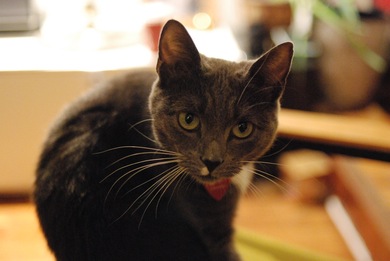
Nikon D80; Nikkor 35mm f/2.0 D; 1/50s, f/2.0, ISO:3200
This delicious kitten's delicious face is sharply in focus, but its fluffy wuffy tummy is all soft and fuzzy like a delicious kitten!
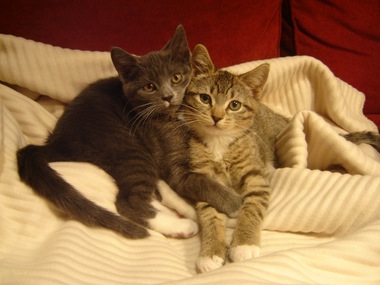
Sony DSC-P73; 1/8s, f/8, ISO:320
These kittens, on the other hand, are all focused, all the time, baby!
Richie Brings the Simple
Okay, so these are the three succulent ingredients of a tasty photographic meal. How do we actually go about controlling them?
The good news is, your camera is a super clever piece of work, and it can handle all of this on its own. Just leave it in full auto mode and it will do all the work for you! And most of the time it'll make a pretty good fist of it!
The bad news is, sometimes if you let it, it's gonna do kind of an average job about it. Stupid camera!
Of course, this isn't really the camera's fault. How is it supposed to know what you wanted out of the photo if you didn't tell it?! A bad photographer always blames his camera.
So, what tools do we have in our box of tricks to enable us to control the exposure, focus, and motion blur in our photos?
Shutter Speed
The shutter is like the camera's eyelid. Most of the time your camera's eye is closed. When you press the photo-taking-button, the camera does a kind of reverse blink, like a giraffe on the tundra, sleeping peacefully till someone shoots it (pow!) with a tranquiliser, and it wakes up, startled, and then the ketamine kicks in and it zonks straight back out again.
The shutter speed refers to how long the eye stays open for.
If we're sticking with the daft giraffe poaching analogy, then the shutter speed is like the potency of the tranquiliser dart. High shutter speed equals highly potent tranqs equals giraffe's eyes are only open for a split-second; it's asleep again before it can even unfurl its long, elegant neck. Zzzzz.
The shutter speed affects two things:
Firstly, and obviously, it affects how much light the camera takes in, and thus the exposure. Slow shutter speed, long exposure, bright photo. Fast shutter speed, short exposure, dark photo.
Secondly, and also obviously, it affects the motion blur. If the shutter opens and closes so quick that even your caffeine induced shakes can't move the camera and even the speeding Ferrari doesn't really get anywhere whilst the shutter's open, then you get no motion blur.
Aperture
Aperture also refers to the eye of the camera - specifically, how WIDE the shutter opens. Like the shutter speed, this also has two effects:
Firstly, and obviously, it affects how much light the camera lets in. If the aperture is small, then the camera is SQUINTING and doesn't let in much light, and hence, low exposure, dark photo. If the aperture is large, the camera is all wide-eyed and innocent, and lets in a whole lotta light - hence, high exposure, bright photo.
The second thing that the aperture affects is the first non-obvious part of this entire tutorial. (Oh, snap!) The aperture controls the depth of field. I don't know why this is, and I can't be bothered to figure it out just for your benefit, because it doesn't really matter. All you need to know is that a large aperture results in a small depth of field, and a small aperture results in a large depth of field. How contrary!
Camera Modes
Okay. A smart kid like you probably noticed something about the two settings we just discussed. Shutter speed affects motion blur. And aperture affects depth of field. But both settings affect exposure. This, combined with your camera's clever electronic ROBOT BRAIN leads us to a rather nifty endpoint.
You can PLAY APERTURE AND SHUTTER SPEED OFF AGAINST EACH OTHER, like a crafty courtier befuddling the king and his barons in an overwrought medieval drama.
So exactly how do you carry out this political intrigue so that all your photos are perfectly exposed? It is simplicity itself! Your camera has several different shooting modes, which control how many of its myriad settings you have DOMINION over, and how many it will look after itself thank-you-very-much.
These generally include:
- M
- is for full-on-you're-playing-with-the-big-boys-now-Manual - Don't use this it is HARD.
- P
- is for PAutomatic - (The 'P' is silent.) Use this when you have a killer hangover and don't want to think. Your camera will pick what it thinks is an appropriate aperture and shutter speed, and your photo will turn out perfectly exposed. (PAutomatic is not really a word. It is actually called "Program" mode, and it differs from the full automatic mode in that it gives you more control over other settings, such as flash or white balance.)
- S
- (or Tv) is for Shutter priority (or Time value) - You set the shutter speed to whatever you want, and your trusty camera sidekick will compensate by adjusting the aperture to give you the perfect exposure.
- A
- (or Av) is for Aperture priority - You set the aperture to your fancy, and your camera butler will set the shutter speed to give your photo - you've guessed it - the perfect exposure.
(And probably some fancy other modes designated by little pictograms designed for special situations like when you are taking photos of the Olympic 100m final - sports mode, baby! Ignore these for now, maybe forever.)
These last two are the important ones. For example, if you want a photo with no motion blur, then set your shutter speed to something fast, and let the camera handle the aperture.
Or, and this is my NUMBER ONE TOP TIP, set your aperture as large as it will go, and let the camera handle the shutter speed. If you do this, your photos will look like a pro took them because the subject of your photo will be crisp but the background will be all blurry. I'm serious. If you do this, people will think you are a modern-day Henri Cartier-Bresson.
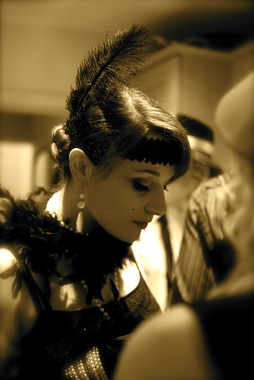
Nikon D80; Nikkor 35mm f/2.0 D; 1/40s f/2.0 ISO:800
SEE? I took this photo and it looks awesome and I can't even take photos!
Can I please take some photos now?
Okay okay, Richie. I get it. I need to try setting the aperture and shutter speed when I'm taking photos. But what should I set them to?
How to use your camera in bright daylight
This one's easy. Leave your camera in full auto mode and snap away! Alternatively, for that "professional photographer" look we talked about earlier, set your camera to a nice large aperture, and blur the heck out of your backgrounds raar!
How to use your camera in dim light
Okay. This is where, without any advanced skill on your part, your camera is going to KICK THE ASS of your friend's puny Sony Cybershot. Here's what you do:
Turn your flash off. It makes people ugly, and it SUCKS the life out of scenes like some kind of terrifying photographic ZOMBIE.
Ceci n'est pas un Bob agrees. Turn it off. It makes your photos bad.
"But wait, Richie," I hear you wail, "Without flash how will there be enough light for my camera to see by?"
To which I refer you to the above. You have already discovered not one but TWO arcane methods by which you can turn your shutter into a veritable CAT'S EYE.
- Slow the shutter riiight down, allowing the camera plenty of time to absorb all that delicious, tasty light. This works better if you're taking a photo of something inanimate (or dead) and unless you're a gunslinger with nerves of steel, you'll probably want a tripod.
- Set your aperture as large as it will go and blast away. This has two excellent effects. Firstly, having your camera's eye propped open with matchsticks means it can suck in lots of light in little time, reducing motion blur. Secondly, IT MAKES YOUR PHOTOS LOOK LIKE A PROFESSIONAL TOOK THEM! WE'VE ALREADY BEEN THROUGH THIS.

Nikon D80; Nikkor 35mm f/2.0; 10 seconds, f/18, ISO:200
If your subject isn't dead, using a really slow shutter might turn them into a ghost.
Get Your Wallet Out
There's just one more thing, and you're not going to like it, because it's probably gonna cost you some money. When you bought your camera, it came with a zoom lens, right?
Of course it did! Zoom lenses are great because you can basically take photos of everything in the world without ever having to get off your lazy butt and walk around. HOWEVER, unless you are super rich, your zoom lens has piggy little eyes. This is especially true if you just settled for the kit zoom that your camera came with by default.
Get out your piggy-eyed zoom lens. What? It has moodily deep set eyes and you actually find it strangely attractive? If you say so. So get out your hunkily deep-setted zoom lens. Have a look at it. Round the side it'll give you its specs which will read something along the lines of: 18-55mm f/3.5-5.6G.
The "18-55mm" part is the focal range of the lens. This is the zoominess of the camera. The smaller the first number the more wide-angle the lens when fully un-zoomed. The larger the second number the more zoomy the lens will be when fully zoomed in. This is all very well and good, but we don't care about these numbers right now.
No sir. The IMPORTANT numbers for the purposes of shaming your Cybershot-toting friends is the second part: f/3.5-5.6G. This is the aperture of the lens, and, to be frank, a maximum aperture of f/3.5 just ain't cutting it.
With this lens, you're occasionally gonna find yourself in a situation where even full aperture ain't gonna get you a shutter speed fast enough to avoid masses of motion blur.
However, if you can snag yourself a lens that's got a maximum aperture of f/2 (or, heavens to Betsy, lower) then you'll find you'll be able to leave your flash switched off even in the most insalubrious of venues.
And that will make your photos look AWESOME.
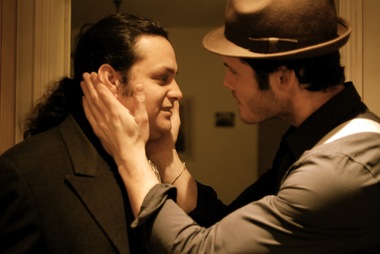
Nikon D80; Nikkor 35mm f/2.0 D; 1/40s, f/2.0, ISO:1000
I'm not kidding. It was proper dark when I took this.
If you still don't believe me, check out this real photographer's rather more lucid and comprehensive explanation of why you should get a lens with a wide aperture.
The good news if you have a film Canon is that this lens is gonna be cheap as chips. The Canon EF 50mm f/1.8 is currently coming in at a whopping $72.10 on Amazon.
On a film camera, 50mm is essentially a "normal" lens, like you would get on a point-and-shoot camera with no zoom.
Unfortunately, if you have a digital SLR, it's going to be a little pricier, as, because of some technical reasons I am going to not explain by waving my hands around, a "normal" lens is a 35mm. The Canon EF 35mm f/2 is currently $236.55 on Amazon. Jiminy! A 50mm will still work, of course. You'll just find that it's a littler zoomier than the 35mm, so you'll have to stand about two feet further back to get the same shot. Try it out in the shop and see if you like it!
Nikon users like myself fare slightly worse, but a new lens still won't break the bank. A Nikon 50mm f/1.8 is currently going for $116.94 on Amazon. The Nikon 35mm f/2.0 seems to be out of stock right now on Amazon, but I'm willing to bet you can find one for under $300.
And just be glad you aren't in the UK. I paid over £200 (~$400) for a Nikon 35mm f/2.0 this Christmas. Ouch!
Further into the Rabbit Hole
What? You've got all that down pat? And you're still hungry? Hungry for more? Well, now you've nailed the basics, there're plenty more camera settings you can start to explore. I'd recommend a few good ones to start with would be:
- The various different auto-focus settings, and the focus lock feature, which allows you to focus on one thing, and then move the camera to point at something else without re-focusing. This is nifty if you want the subject of your photo to be off centre, for example.
- Similarly, the exposure lock feature.
- White Balance. You know how when you take photos indoors everything looks all yellowy, but if there's fluorescent lighting then everything looks all cold and blue? This is because different light sources give off different coloured light, and it can sometimes give you quite a cool effect. A lot of the time, however, you won't want this, and so your camera can compensate with jiggery-pokery and make your photos look NORMAL again, whatever the weather. James Duncan Davidson has an excellent primer on the details of the UNDERHANDED non-white colour of OSTENSIBLY white light.
- Auto Exposure Bracketing. This is a nifty feature that allows you to experiment with exposure by automatically taking three (or more!) photos in a burst, one at the standard, automatically calculated, exposure, and then others a bit above and below that. Sneakiness!
-
RAW mode. (This one can be ignored unless you're getting into photography as a serious hobby. Or profession!) Your camera is capable of taking photos in two different formats. JPEG, and RAW. When shooting in JPEG, your camera CALLOUSLY disgards a lot of information from every shot. So to retain some of this detail, and especially if you're interested in doing some serious post-processing on your photos, you'll want to look into shooting RAW. However, be warned... it's a bit of a faff. You can't, for example, send RAW images that you took of your sister's new baby to your aunt Gladys in Australia.
Well, you can, but your aunt will be all like, "Strewth, mate! I can't open these piccies you've sent me! G'day!" (I have not been to Australia, but that is how Australians talk, right? Right?)
RAW is like a particularly untidy handyman to JPEG's effete gentleman - he can get more done around the house, but he'll require a lot of work before you can take him to tea with the queen. Digital Photography School have a great, simple article about the differences between JPEG and RAW, which I've just found. In fact, they have a great series of photography tutorials there, which, to be honest, you would have been much better off reading than my effort. You've already read this one now though, so HAH!
- Feeling sassy? Why not grow a pair and try shooting in manual. The reasoning being, it makes you think about what you want your photo to look like. And you know what? Your squishy, delicious, spicy brain is actually BIGGER than your camera's, and, once you know what you're doing, you might actually make better decisions than it. Disclaimer: I don't shoot in manual. I told you already, it's HARD.
In Conclusion
I hope you've enjoyed our little meander through the winding pathways of the garden of photography.
I also hope you've LEARNED something.
But most of all, I'm just pleased you've made it all the way down to the end. Seriously guys, that's a good ten minutes of your life you're NEVER getting back.
Now go take some photos!
Comments? Profuse gratitude? Money? Lenses that you've decided you no longer need and would like to go to a good home? Send them to me at phot...@whileyouweregone.co.uk or @whenyougotback.
